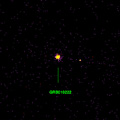CXC Home | Search | Help | Image Use Policy | Latest Images | Privacy | Accessibility | Glossary | Q&A
Q&A: X-ray Astronomy
Q:
I want to know if the image of GRB-010222 can be examined for
red shift. Can GRBs be measured that way?
A:
The best way to get a red shift for a gamma ray burst is to catch
it soon after the outburst and measure the red shift of the host
galaxy with an optical telescope. This is sometimes possible
with an X-ray telescope (for example GRB 991216). For GRB
010222, observations using the Keck telescope indicate that the
red shift is 2.04.
Abstract:
The gamma-ray burst (GRB) 010222 is the brightest GRB detected
to date by the BeppoSAX satellite. Prompt identification of the
associated optical transient (OT) allowed for spectroscopy with
the Tillinghast 1.5 m telescope at F. L. Whipple Observatory
while the source was still relatively bright (R~=18.6 mag),
within 5 hr of the burst. The OT shows a blue continuum with
many superposed absorption features corresponding to metal lines
at z=1.477, 1.157, and possibly also 0.928. The red shift of GRB
010222 is therefore unambiguously placed at z>=1.477. The
high number of Mg II absorbers and especially the large
equivalent widths of the Mg II, Mg I, and Fe II absorption lines
in the z=1.477 system further argue either for a very small
impact parameter or that the z=1.477 system is the GRB host
galaxy itself. The spectral index of the OT is relatively steep,
Fν~ν-0.89+/-0.03, and this cannot be caused by dust with a
standard Galactic extinction law in the z=1.477 absorption
system.



